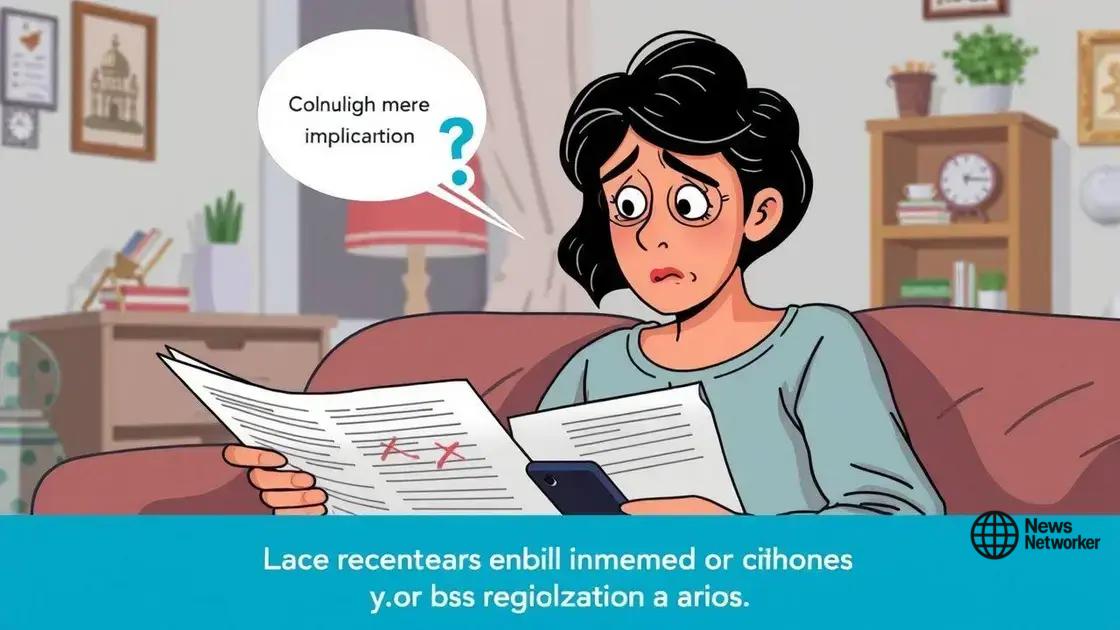Curtailment of CFPB regulatory scope: What it means for consumers

The curtailment of CFPB regulatory scope decreases consumer protections, increasing risks such as higher fees and predatory practices, while also potentially leading to benefits like market competition and innovation in financial products.
The curtailment of CFPB regulatory scope raises significant questions about consumer protections. What does this mean for your financial rights? Let’s delve into the details and explore the potential impacts.
Understanding the CFPB and its mission
The Consumer Financial Protection Bureau (CFPB) plays a crucial role in overseeing financial products and services. Understanding its mission helps consumers navigate financial choices effectively.
CFPB’s Core Functions
The CFPB is dedicated to ensuring that consumers are treated fairly by financial institutions. It focuses on several key areas:
- Regulation: The CFPB designs and enforces regulations that protect consumer rights.
- Education: It provides resources to help consumers make informed financial decisions.
- Oversight: The bureau monitors financial companies to ensure compliance with federal laws.
- Complaint Resolution: Consumers can file complaints about financial products and services.
By understanding the CFPB’s functions, consumers can better access the tools and resources available to them. This agency is committed to promoting fair practices in the financial sector.
History of the CFPB
The CFPB was established in 2010 following the financial crisis to prevent future consumer abuses. Since then, it has worked to create an environment of transparency in financial transactions. The bureau’s mission emphasizes the importance of protecting consumers from unfair, deceptive, or abusive practices in the financial sector.
Through its various initiatives, the CFPB aims to empower consumers with knowledge, enabling them to make confident choices regarding mortgages, credit cards, and loans. These efforts are essential in fostering a more equitable financial landscape.
As the agency evolves, staying informed about its mission can help consumers understand their rights and responsibilities, potentially safeguarding them against financial pitfalls.
Recent changes to the CFPB’s regulatory powers
Recent changes to the CFPB’s regulatory powers have sparked considerable debate. These modifications impact how the agency interacts with financial institutions and protects consumers.
Overview of Regulatory Changes
The CFPB has seen shifts in its authority, often influenced by political and economic factors. These changes can affect the level of consumer protection readily available. For instance, some regulations have been rolled back, raising concerns about the potential for increased risks to consumers.
- Modification of enforcement metrics: Changes in how the CFPB evaluates compliance may lessen accountability for financial companies.
- Reduced oversight on smaller lenders: The agency has adjusted its scrutiny of non-bank financial institutions.
- Shifts in funding: Budget changes can affect the CFPB’s resources, impacting its ability to serve consumers effectively.
Alongside these shifts, consumer advocacy groups express concern about the long-term implications for financial protections. The feeling is that consumers may face a less favorable landscape without proper oversight.
The Impact on Consumers
As the regulatory landscape evolves, the implications for consumers become clear. Reduced protections may lead to a rise in unfair practices, affecting individuals looking to secure loans or mortgages. It’s essential for consumers to remain vigilant and informed about their rights in this changing environment.
In this context, understanding the recent changes to the CFPB’s regulatory powers becomes vital. Staying proactive and engaging with available resources can help consumers navigate these uncertain waters effectively.
Key implications for consumers

Understanding the key implications for consumers regarding the curtailment of CFPB regulatory scope is essential in today’s financial landscape. With changes in regulation, consumers may face several challenges that could directly impact their financial well-being.
Increased Risks
One significant implication of reduced oversight is the potential for increased risks. When the CFPB scales back its regulatory authority, financial institutions may become less cautious. This change can lead to:
- Higher fees: Without stringent regulations, banks and lenders may introduce more fees, increasing the overall cost of financial services.
- Predatory practices: Companies might exploit vulnerable consumers, leading to unfair lending practices.
- Lack of transparency: Consumers may find it harder to understand the terms and conditions of financial products.
As these risks grow, consumers must stay alert and informed about their rights and the changing environment.
Impact on Access to Credit
Another important implication is the potential decline in access to credit. With fewer regulations, lenders may tighten their lending criteria, making it harder for individuals, particularly those with less-than-perfect credit, to secure loans. This situation could leave many consumers in a difficult position when they need financial assistance.
Additionally, this tightening could lead to a rise in interest rates, further complicating efforts to obtain loans. The overall effect may be a financial atmosphere that is less welcoming to those seeking help.
Overall, being aware of these key implications allows consumers to make more informed decisions. Staying engaged with financial matters becomes critical in navigating these changes.
Potential risks and benefits
Exploring the potential risks and benefits of the curtailment of CFPB regulatory scope is crucial for consumers in today’s financial environment. Understanding both sides can help individuals navigate their financial choices better.
Potential Risks
As the CFPB’s powers decrease, consumers face several risks that could impact their financial security. It is important to acknowledge these challenges:
- Increased Fees: Banks and financial institutions may feel less pressure to keep fees low, potentially raising costs for consumers.
- Limited Consumer Protection: The rollback of regulations may lead to a rise in unfair practices, leaving consumers vulnerable to exploitation.
- Difficulty in Resolving Complaints: With reduced oversight, consumers might find it harder to address issues with financial products and services.
These risks indicate a landscape where consumers need to be more vigilant in their financial dealings.
Potential Benefits
Despite the risks, there are also potential benefits that could arise from easing regulations. Some argue that this could lead to:
- Increased Market Competition: Lower regulations may encourage new players to enter the market, fostering competition and possibly lower prices.
- Innovation in Financial Products: Less restrictive regulations can allow companies to develop new and innovative financial solutions for consumers.
- Greater Access to Credit: Some lenders might expand their offerings, making credit more accessible to a broader range of consumers.
These potential benefits emphasize that the situation is complex, often presenting both opportunities and challenges for consumers. Therefore, awareness is key to making informed decisions.
How to advocate for consumer protection
Knowing how to advocate for consumer protection is essential in a landscape where the CFPB’s regulatory scope may be curtailed. Consumers can take proactive steps to ensure their rights are upheld and to promote safe financial practices.
Raise Awareness
One of the first steps in advocacy is to raise awareness about consumer rights. You can achieve this by:
- Sharing Information: Educate friends and family about their rights as consumers.
- Engaging in Community Education: Attend or host workshops focused on consumer rights and financial literacy.
- Using Social Media: Share articles and resources related to consumer advocacy.
Informed consumers are empowered consumers, ready to stand up for their rights.
Participate in Advocacy Groups
Joining consumer advocacy groups can amplify your voice. These organizations often work to:
- Lobby for Stronger Regulations: Advocate for consumer-friendly policies at both state and federal levels.
- Provide Resources: Offer tools and support for consumers experiencing issues with financial institutions.
- Raise Funds: Support initiatives that promote consumer education and protection.
By teaming up with others who share your values, your collective efforts can lead to meaningful change.
Contact Your Representatives
Engaging with elected officials is crucial in advocating for consumer protection. You can:
- Write Letters or Emails: Express your concerns directly to your representatives about specific consumer issues.
- Attend Town Hall Meetings: Participate in discussions about financial regulations and the importance of consumer protection.
- Vote for Supportive Candidates: Use your voting power to support leaders who prioritize consumer rights.
These actions help ensure that consumer interests remain front and center in policy discussions. Advocacy is a continuous effort that requires collective participation and dedication.
FAQ – Consumer Protection Advocacy
What is the CFPB?
The Consumer Financial Protection Bureau (CFPB) is a government agency that ensures consumers are protected from unfair financial practices.
How can I raise awareness about consumer rights?
You can raise awareness by educating friends and family, sharing articles online, and participating in community events focused on financial literacy.
Why is it important to join advocacy groups?
Joining advocacy groups connects you with others who share the same goals and amplifies your voice to influence policy changes.
How can I contact my elected representatives?
You can contact your representatives by writing letters, sending emails, or attending town hall meetings to discuss consumer protection issues.





